Eye teeth are a folk term, not a medical one. In common people, this is usually the name of the upper canines, and by analogy with them, the lower ones.
Probably, the canines got their special name due to the fact that branches of the facial nerve are located next to them, when irritated, strong pain sensations arise, spreading to the upper half of the face and giving into the eyes. That is why, when a child develops milk eye teeth, it is accompanied by excruciating pains and other unpleasant symptoms. And because of this, removal of canines in adults is a very painful procedure that requires serious anesthesia.
Despite their name, eye teeth do not affect vision in any way. Although it is quite common for dental patients to express the opinion that if a canine is removed, it is easy to go blind, this prejudice has no medical evidence and is erroneous.
Location
The eye teeth or canines are arranged in pairs on the upper and lower jaws. They occupy an intermediate position between the anterior and posterior teeth, adjacent to the lateral incisors and molars (in the milk bite) or to the small molars (in the permanent dental set).
The laying of milk eye teeth begins from the second month of embryogenesis. Like other teeth, they originate from the dental plate of the oral epithelium, but penetrate into the developing bone tissue a little deeper than the rest. The development of permanent canines and the entire root set begins a little later (at about 4 months of intrauterine development), but occurs identically to the establishment of milk teeth.
Canines are characterized by the following features that distinguish them from other teeth:
- The presence of a single rather long root, which is somewhat compressed at the sides.
- A massive crown with 2 incisal edges, converging at an acute angle.
- The crown has a slightly flattened shape, in which the labial and lingual surfaces are connected at the incisal edge.
- The upper canine is slightly larger than the lower canine, it has a longer incisal edge and wider contact surfaces.
Such features in the location and structure of the eye teeth make it possible to perform well their main function: holding food and tearing it into pieces.
Teething in infants
The baby's milk teeth in the baby's mouth erupt in a certain order, according to which the eye teeth appear only after all the incisors and first molars. In this case, the upper canines climb a little earlier (at 16-18 months) than the lower (at 18-20 months). Such a rather late appearance of the eye teeth is explained by their deeper location in the jaw. And for the same reason, their eruption is the most unpleasant for a child.
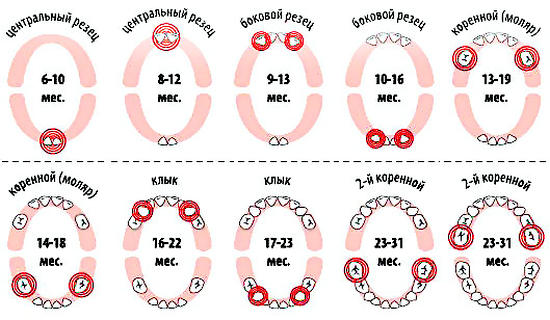
Most mothers know that eye teeth are the “heaviest” teeth in babies. How long the fangs are cut in a baby, so much can be moderately elevated body temperature, a runny nose may appear due to edema of the mucous membrane of the mouth and nose. During this period, the child is very moody, whiny, his sleep and appetite are disturbed. All this is a normal reaction of the child's body to inflammation of the gums over the erupting tooth.
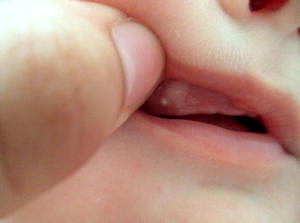 Upper ocular tooth
Upper ocular tooth 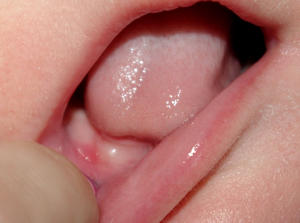 Lower ocular tooth
Lower ocular tooth
But if a child has a high temperature of up to 39 degrees and above, accompanied by cough, vomiting, diarrhea and general intoxication, it is important to remember that these are most likely not signs of teething, but symptoms of a serious illness.
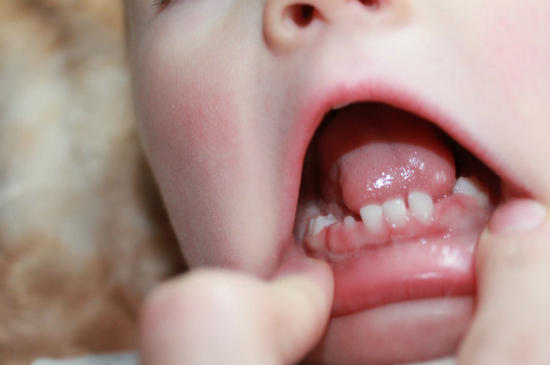 In the photo: teething of eye teeth in a child
In the photo: teething of eye teeth in a child
How to relieve the symptoms of erupting canine teeth?
A number of methods can be used to make the appearance of a canine tooth less disturbing to the child:
- Light massage of the gums... With a clean forefinger, gently massage the gum over the eye tooth for 1-2 minutes. It is advisable to repeat this procedure 2-3 times a day.
- You can give the baby a gnaw special teethers with cooling effect, which must be put in the refrigerator for a while before use. They are usually filled with sterile distilled water, so even if the child accidentally bites through the shell, it will not harm his health.
- To relieve pain, you can lubricate sore gums several times a day. pain relieving gels(Dentinox, Kalgel, Kamistad). They begin to act within a few minutes and relieve pain well over the erupting tooth.
- If the appearance of eye teeth is accompanied by nasal congestion, then to relieve this unpleasant symptom, you can use children's vasoconstrictor drops(Otrivin, Nazivin, Quicks).
- When the temperature rises above 38 degrees, a reception is required antipyretics(Paracetamol or Ibuprofen), which are available in child-friendly forms: syrup or suppositories.
How many days it is necessary to carry out such activities for each baby is decided individually. In any case, you need to consult a pediatrician.
Features in adults
Despite the fact that eye teeth are usually more of a concern for young children, adults also often have questions related to certain problems with canines.
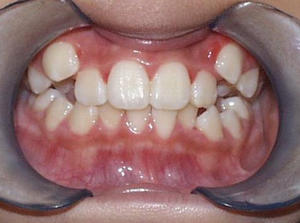
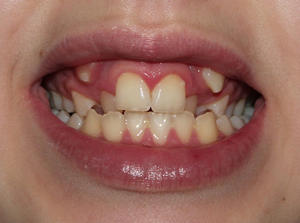
- How old is the change of milk canines for permanent ones? Usually, the eye teeth on the upper jaw appear a little later than on the lower. The estimated age when the lower canines grow is 9-10 years, and the upper ones - 11-12 years.
- How do permanent eye teeth appear and can they erupt earlier than the front ones? Fangs in permanent bite appear fifth in a row - after the first molars (5-6 years), central and lateral incisors (6-9 years), the first premolars (10-12 years). Violation of such a scheme for the eruption of permanent teeth can be both an individual feature of a person and a sign of serious dental pathology (for example, adentia due to the death of the rudiments of permanent teeth).
- Why can an eye tooth hurt? Normally, a healthy person should not have any soreness in the area of the teeth. If, nevertheless, an eye tooth hurts, then this may be a sign of a formidable pathology: periostitis (gumboil), pulpitis, periodontitis and others. In any case, you should not engage in self-treatment - it is better to contact a dentist for qualified help. The only thing you can do before your doctor's appointment is to take a pain reliever.
- What to do if an eye tooth has grown incorrectly? Anomalies of the dentition in the form of crooked teeth are quite common. In some, this defect is practically invisible, but sometimes the canines erupt at a considerable distance from the intended place. This situation can be corrected by orthodontic treatment (braces, aligners), but sometimes, in especially severe cases, for alignment of the dentition the doctor suggests pulling out a crooked tooth.
- Can I remove my eye teeth? Removing any tooth is an extreme measure, which the dentist takes only as a last resort. And fangs are no exception to the rule. Premature loss of a milk eye tooth can lead to the formation of a malocclusion, and its removal in an adult significantly impairs the chewing function of the teeth, and also negatively affects a person's appearance. But if you still had to pull out the canine, then you should carry out its prosthetics as early as possible.
While the eye teeth are special, the importance of the rest should not be underestimated. It is necessary to carefully monitor the state of the oral cavity - only this will help to maintain a healthy and beautiful smile until a ripe old age.





